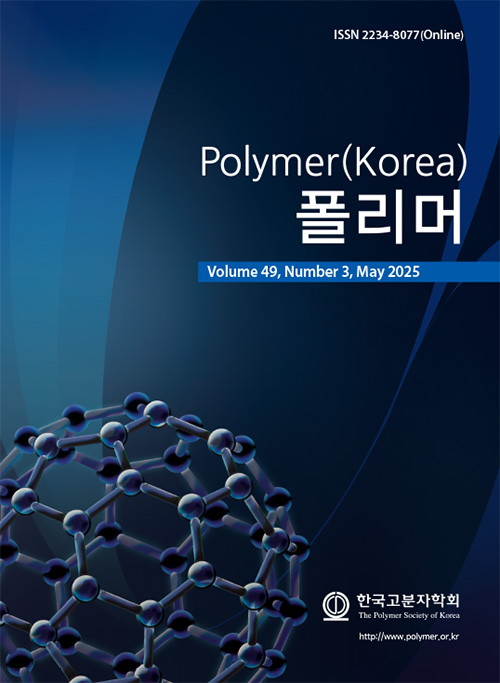- Scalable Fabrication of Electrochromic Films Using a Cobalt-Complexed Poly(N-vinylcarbazole) Metallopolymer
Department of Chemical Engineering, Pohang University of Science and Technology (POSTECH), Pohang, Gyeongbuk 37673, Korea
*Department of Chemistry, Kyonggi University, Suwon 16227, Korea- 코발트 배위된 폴리(N-비닐카바졸) 초분자 금속고분자를 이용한 저비용 전기변색 박막 제조법
포항공과대학교 화학공학과, *경기대학교 화학과
Reproduction, stored in a retrieval system, or transmitted in any form of any part of this publication is permitted only by written permission from the Polymer Society of Korea.
This study introduces a cost-effective method for fabricating electrochromic (EC) films using a cobalt-complexed poly(N-vinylcarbazole) (PVK-3-tpy-Co) supramolecular metallopolymer. The polymer, functionalized with terpyridine groups, was synthesized through a streamlined process and coordinated with cobalt ions via a simple aqueous method. The resulting EC films exhibited excellent redox stability, dynamic color modulation, and high optical contrast, as confirmed by UV-vis spectroscopy and cyclic voltammetry. This scalable approach highlights the potential of PVK-3-tpy-Co for sustainable and high-performance electrochromic applications.
이 연구에서는 코발트 배위된 폴리(N-비닐카바졸) (PVK-3-tpy-Co) 초분자 금속고분자를 이용한 경제적이고 효율적인 전기변색(EC) 박막 제조 방법을 제안한다. 테르피리딘 작용기를 도입한 이 고분자는 간소화된 합성 공정을 통해 제조되었으며, 수용액 기반의 간단한 배위 반응을 통해 코발트 이온과 결합되었다. 제조된 EC 박막은 자외선-가시광선(UV-vis) 분광법 및 순환 전압전류법(cyclic voltammetry)을 통해 분석한 결과, 우수한 산화-환원 안정성, 동적 색 변화, 높은 광학 대비를 나타내었다. 본 연구에서 제시한 확장 가능한 제조 접근법은 PVK-3-tpy-Co의 지속 가능하고 고성능 전기변색 응용 가능성을 시사한다.
Keywords: electrochromic materials, supramolecular metallopolymers, conjugated polymers, cobalt coordination complexes, terpyridine functionalization.
- Polymer(Korea) 폴리머
- Frequency : Bimonthly(odd)
ISSN 2234-8077(Online)
Abbr. Polym. Korea - 2024 Impact Factor : 0.6
- Indexed in SCIE
 This Article
This Article
-
2025; 49(3): 359-364
Published online May 25, 2025
- 10.7317/pk.2025.49.3.359
- Received on Jan 13, 2025
- Revised on Jan 27, 2025
- Accepted on Jan 28, 2025
 Correspondence to
Correspondence to
- Minjun Kim
-
*Department of Chemistry, Kyonggi University, Suwon 16227, Korea
- E-mail: minjun.kim@kyonggi.ac.kr









 Copyright(c) The Polymer Society of Korea. All right reserved.
Copyright(c) The Polymer Society of Korea. All right reserved.